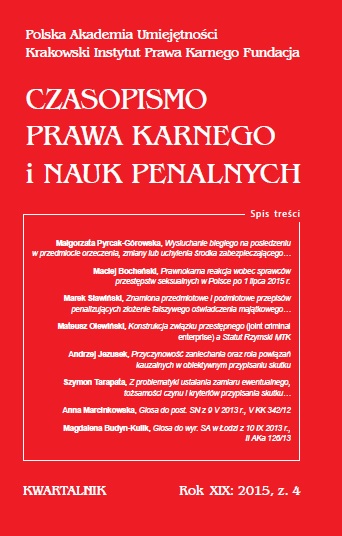Konstrukcja związku przestępnego (joint criminal enterprise) a Statut Rzymski Międzynarodowego Trybunału Karnego
Joint criminal enterprise and the Rome Statue of the International Criminal Court
Author(s): Mateusz OlewińskiSubject(s): Criminal Law, International Law
Published by: Polska Akademia Umiejętności / Krakowski Instytut Prawa Karnego Fundacja
Keywords: perpetration of an international crime; joint criminal enterprise; The Rome Statue; co-perpetration; indirect co-perpetration
Summary/Abstract: Celem artykułu jest próba odpowiedzi na pytanie o możliwość stosowania konstrukcji związku przestępnego przez Międzynarodowy Trybunał Karny. W pierwszej części opracowania autor prezentuje omawianą konstrukcję w kształcie wynikającym z orzecznictwa Międzynarodowego Trybunału Karnego dla byłej Jugosławii. Druga część tekstu poświęcona jest przedstawieniu rozumienia art. 25 ust. 3 Statutu Rzymskiego Międzynarodowego Trybunału Karnego w dotychczasowym orzecznictwie trybunału. Orzecznictwo to dotyczy przede wszystkim współsprawstwa, współsprawstwa pośredniego oraz podstawy odpowiedzialności, o której mowa w art. 25 ust. 3 lit. d statutu. Mimo że nie jest ono jeszcze zbyt bogate, wyraźnie widać, że orzecznictwo trybunału jugosłowiańskiego nie będzie stanowić punktu odniesienia przy wykładni postanowień Statutu Rzymskiego. W trzeciej części opracowania autor stara się odpowiedzieć na pytanie o możliwość stosowania konstrukcji związku przestępnego przez Międzynarodowy Trybunał Karny. Dochodzi do wniosku, że tylko pierwsza postać omawianej konstrukcji, będąca w istocie współsprawstwem rozumianym na gruncie teorii subiektywnej, mogłaby być wykorzystywana przez Międzynarodowy Trybunał Karny. The aim of this paper is an attempt to answer the question whether joint criminal enterprise doctrine can be used by the International Criminal Court. After short introduction, in the second part of the paper author presents discussed doctrine in a shape resulting from jurisprudence of the International Criminal Court for the former Yugoslavia. The third part is dedicated to the presentation of an understanding of the article 25 (3) of the Rome Statue of the International Criminal Court in the current jurisprudence of the Tribunal. This jurisprudence concerns above all co-perpetration, indirect co-perpetration and mode of liability mentioned in the article 25(3)(d) of the Statue. Although this jurisprudence is not very rich, we can conclude that jurisprudence of the International Criminal Court for the former Yugoslavia will not be a point of reference for the interpretation of the provisions of the Rome Statue. In the fourthpart of the paper author tries to answer the question whether joint criminal enterprise doctrine can be used by the International Criminal Court. He concludes that only first form of the discussed doctrine, which is in fact co-perpetration understood on the ground of the subjective theory, could be applied by the International Criminal Court.
Journal: Czasopismo Prawa Karnego i Nauk Penalnych
- Issue Year: 19/2015
- Issue No: 4
- Page Range: 57-84
- Page Count: 28
- Language: Polish

